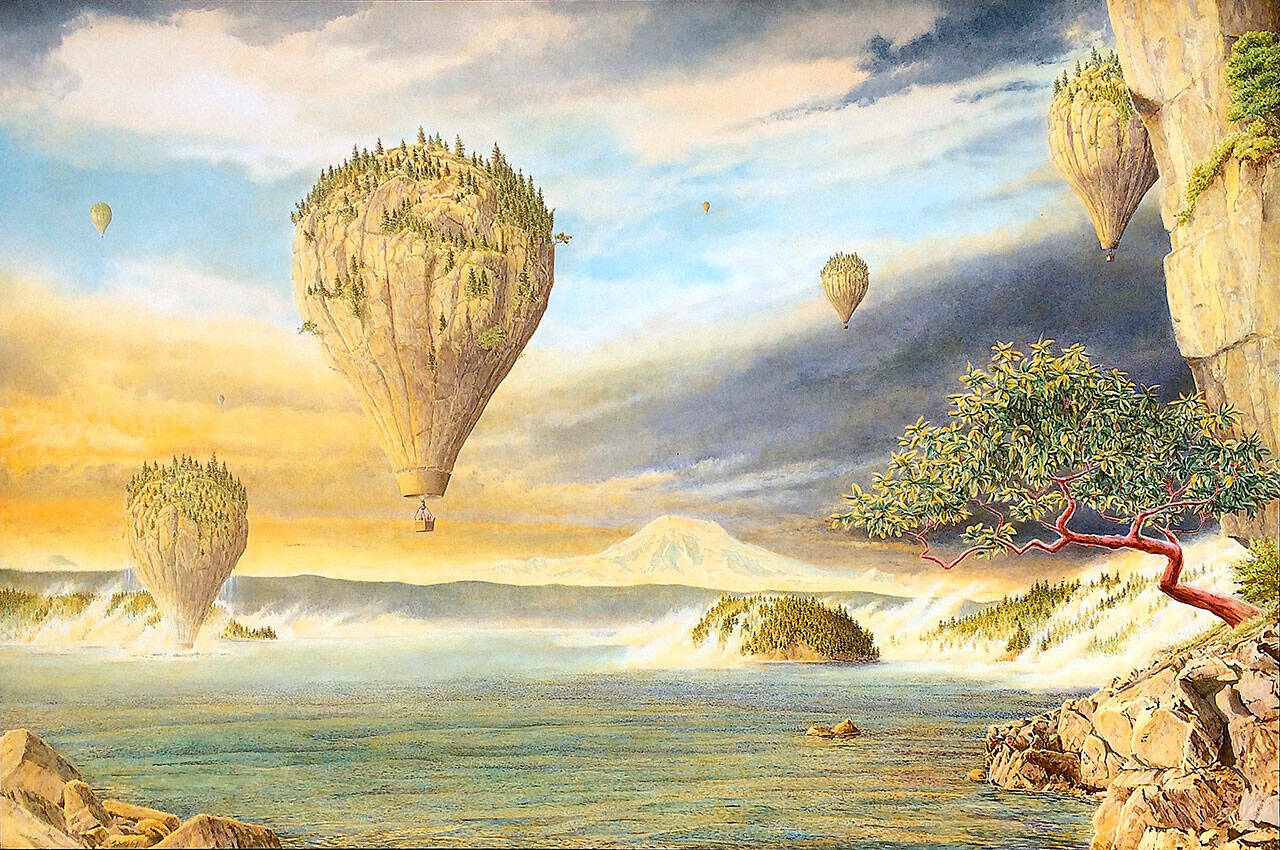This time around, Rob Schouten himself gets the spotlight at Rob Schouten Gallery & Sculpture Park.
The October show, “Aquatint Etchings and Paintings,” features six aquatint etchings and five oil paintings by the gallery owner. His works examine the mysteries of nature and stretch the imagination.
“Because the gallery’s been doing so well, my time to paint has been reduced greatly,” said Rob Schouten, the namesake of the gallery. “I used to do probably half a dozen paintings a year. I currently do two maybe paintings a year.”
A self-taught painter and printmaker, Schouten earned a bachelor’s degree in graphic design at The School for Graphic Arts in the Netherlands. After working in advertising for about a year, he moved to Seattle and became an artist.
This is just the second time Schouten, 64, has had his own exhibit at the Rob Schouten Gallery. His last exhibit was held in 2017.
“As a gallery owner, it matters a lot to Rob that all of our artists are well represented,” gallery co-owner Victory Schouten said. “He tends to shortchange himself.”
His etchings were made with the Island International Artists on Guemes Island about 1998. In the aquatint etching method, the printing plate is blocked out, step by step, from a snowy white to a velvety black. It allows for the artist to work with a broad scale of grays to create an image.
“I have shown one or two at a time in the gallery, but I’ve never shown all six of them at once,” Rob Schouten said. “We printed them in black and white, which is what I had always preferred with them.”
His recent paintings are done in transparent oil glazes in the underpainting technique. A layer of paint is applied to the canvas prior to painting it. It serves as a blueprint for the image, allowing the artist to master light, value and contrast.
Schouten’s work is inspired by surrealists like M.C. Escher, Salvador Dalí and René Magritte, as well as symbolists like Gustave Moreau, Odilon Redon and Gustav Klimt.
He is most proud of “Confluence,” an elaborate painting in oil on canvas. A radiating pattern of squares shows a mountain stream, its rocky banks covered in logs, ferns and moss. Outside of the squares is Mount Shuksan in the background and Picture Lake in the foreground.
“I’ve made a mask for the painting so that in the gallery I can show the image that is inside the squares,” he said. “It’s a very complicated image, so it’s very hard to see what exactly is going on with it.”
One aquatint etching and one oil painting, inspired by the San Juan Islands, are both titled “Skylands.” When the fog is rising off the water, the islands seem to be floating on the clouds — so he painted the islands as if they were hot air balloons.
“You know how the islands look like that up here, right?” Victory Schouten said. ‘They’re just these perfect round things where you wouldn’t be surprised if they just lifted off.”
Schouten sold his paintings at Seattle’s Pike Place Market from 1980 to 1982, then when he moved to Whidbey Island in 1983, showed his work in galleries like Kirsten Gallery in Seattle, the La Conner Gallery and Carolyn Hartness Gallery in Seattle. He worked in watercolor, but now he prefers oil.
Also featured at the gallery through Nov. 1 is new artwork by 12 Northwest artists — you’ll see fresh paintings, sculptures, glass and woodwork.
The artists are Robert Adamson, Anne Belov, Kathleen Frugé Brown, Carolyn Doe, Georgia Gerber, Dan and Joi LaChaussée, Steph Mader, Gerard Del Monte, Sharon Spencer, Don Wodjenski and Angèle Woolery. Each artist will have one or two works on display.
Owners Rob and Victory Schouten founded the gallery in 2008. Rob serves as the artistic director; Victory is the managing director. In 2016, they moved their operation from Greenbank to Langley and added a sculpture garden.
Victory Schouten said her favorite in the show is “After the Fall.” The oil painting inspired by the Wilbert Trail at South Whidbey State Park shows a fallen tree in the background and skunk cabbage in the foreground — the new opening in the canopy let in more light for new grow. Hidden in the roots of the tree is a Buddha.
“There’s this peace pervading,” she said. “A great tree falling is a destructive thing to have happen, but yet there is growth that comes from it.”
Rob and Victory met because of his art. Victory was working as the marketing director for the Seattle Group Theatre in 1987.
The Seattle Group Theater, which shut down in 1998, showcased Seattle area artists in the lobby of its playhouse. An artist’s works were available for purchase and hung in the lobby during the run of a show.
When Victory’s featured artist for “Orphans” backed out, Rob offered to fill in. They married about a year later.
“It’s a window into what an interesting man he is,” said Victory Schouten, who has been his fan from the start. “How thoughtful he is, how he notices and cares.”



